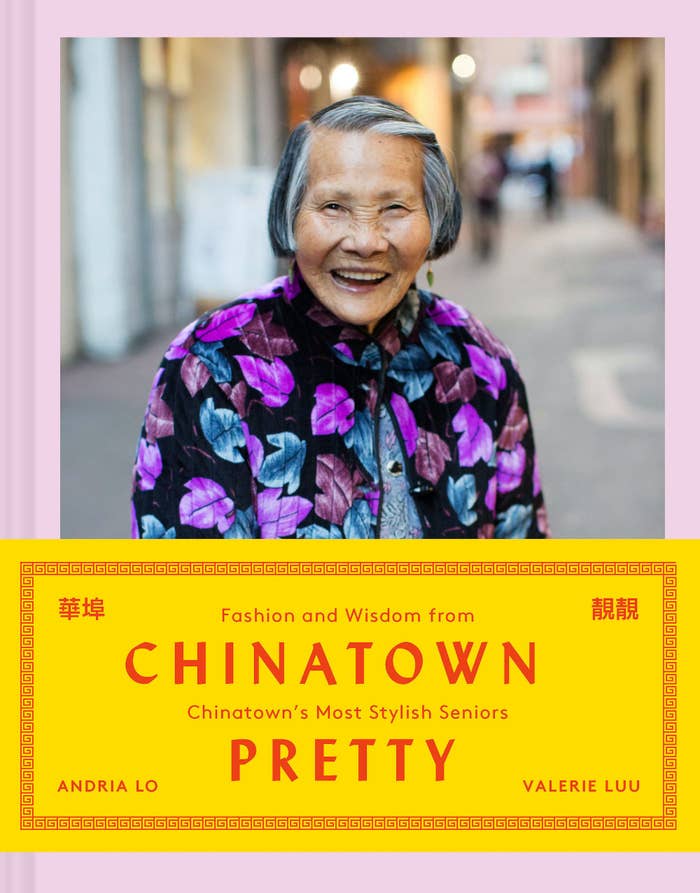
Since 2014, photographer Andria Lo and writer Valerie Luu have been interviewing and photographing Chinatown's most fashionable seniors for their blog and Instagram. Now a book from Chronicle Books, Chinatown Pretty features beautiful portraits, life stories, and pieces of advice from fascinating subjects across six different Chinatowns. Below, 13 of those interviews.
You Tian Wu: Broadway, San Francisco
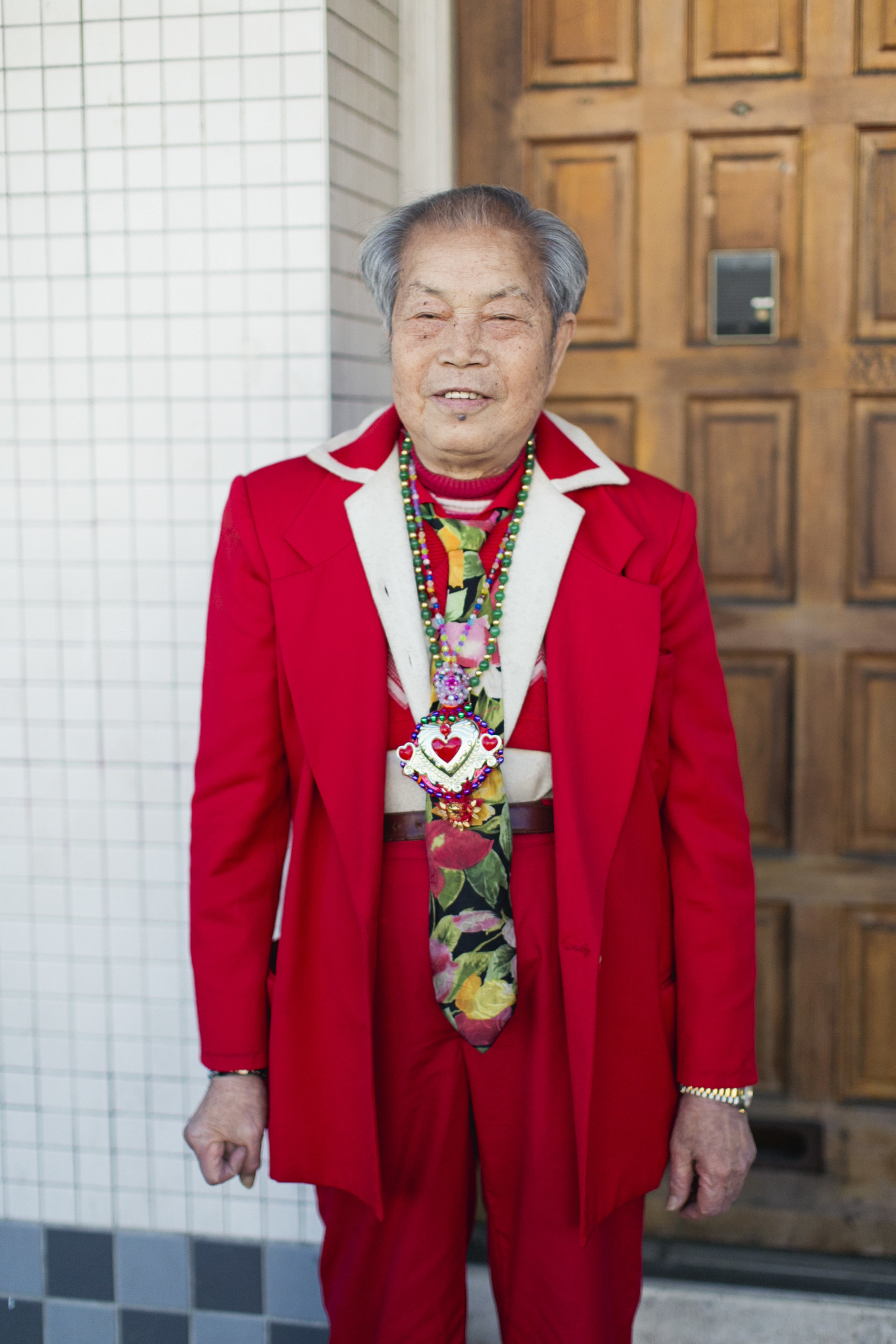
We came across Mr. Wu on Accidental Chinese Hipster, a blog that posts readers’ submissions of Chinatown fashion. Someone had submitted a photo of Mr. Wu riding the Muni, which inspired the blogger to dub him “The One” — someone you may “tragically never unite with” but are “connected to by Fate.”
Lucky for us, we got to meet him by chance. We went to a dim sum joint on Broadway after a long day of shooting and sat down next to him at a table. Our eyes grew wide when we realized he was “The One,” clad in his signature red suit and a bolo tie fashioned out of old Mardi Gras beads.
We talked to Mr. Wu, 82, about his fashion philosophy: “When you’re young you don’t have to care about fashion. But when you’re old, you have to.”
Run Jin Ou Yang: Powell Street, San Francisco

Run Jin Ou Yang, 83, lives at the YWCA, an affordable housing building designed by the famous Californian architect Julia Morgan. She was out on a walk with her daughter wearing a freshly trimmed bob that she’d cut herself, an oversize plaid blazer, emerald green elastic-waist pants, and a fun floral silk shirt.
We interviewed her in her apartment, where she told us about her 30-year teaching career in a rural village in Guangdong Province. “As a teacher, you need to have a lot of love,” she said. “Treat them like your own kids. Don’t treat them like students.”
After she retired in her 60s, she moved to the United States. When we tried to get more details about her immigration, she told us she has Alzheimer’s. “It’s hard to remember the past,” she said.
But she reassured us that she’s living happily — she spends her time going out for dim sum and keeps in touch with family and friends. “I have no cares. I have nowhere I need to be,” she said. “The kids and grandkids are OK, so there’s nothing to worry about.”
She said she was a perfectionist when she was younger. “Now I’m carefree. If I remember, I remember. If I don’t, I don’t.”
Angie No Good: Grant Street, San Francisco
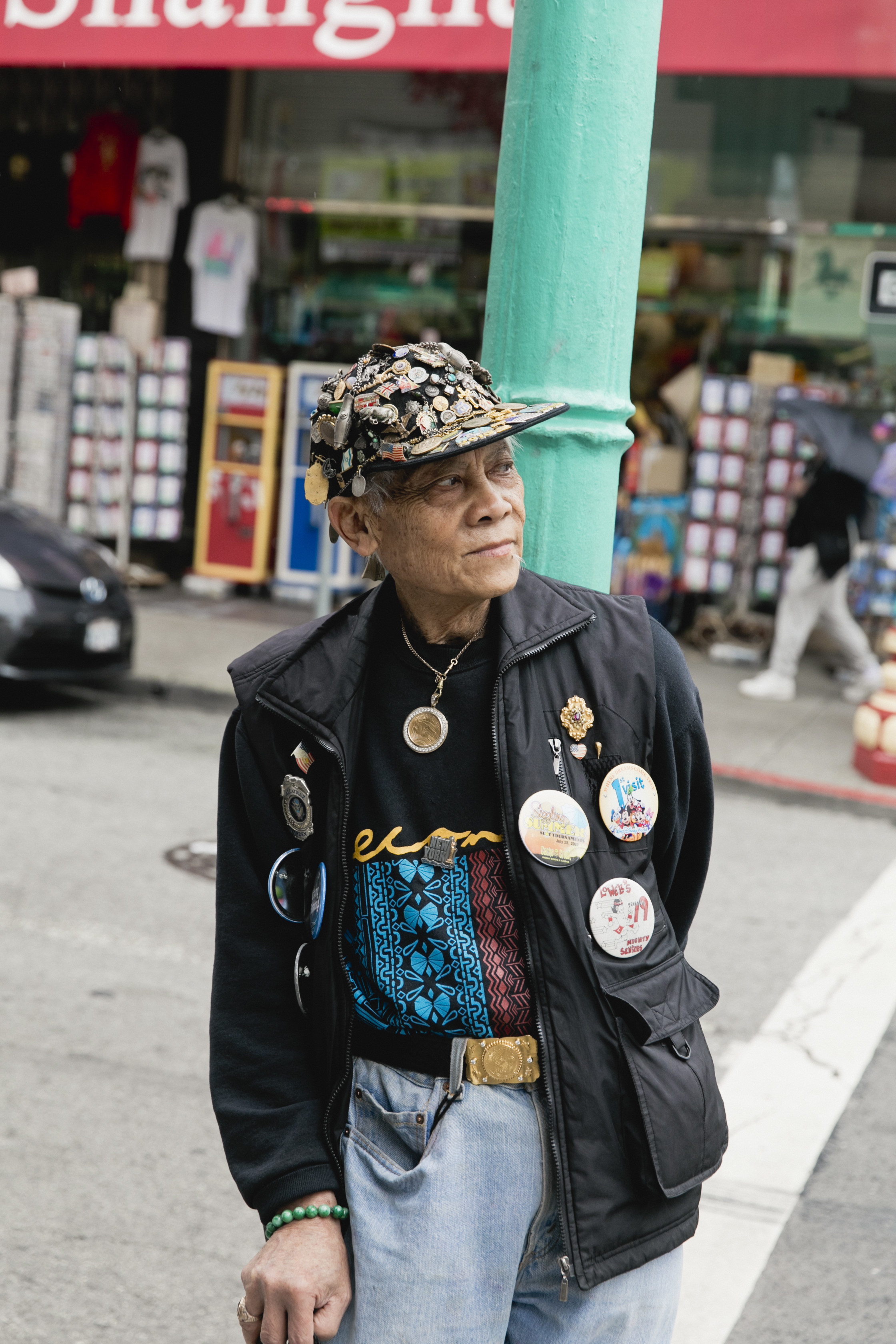
We couldn’t believe we hadn’t met this San Francisco Chinatown resident before, but there he was one afternoon, casually leaning up against a light pole on Grant Street, wearing a cap encrusted with enamel pins from his travels around the world.
“What’s your name?” we asked.
“Angie,” he said. “Angie No Good.”
His punk name matched his punk attitude. When we saw him again a year later, he was wearing the same outfit, except with a few more Cache Creek Casino pins and gold jewelry. This time we had more time to chat before he caught the 12 Folsom bus on Pacific Street.
As for the bling, he wore a watch, belt, bracelet, ring, pin, necklace, keychain, and a sphinx-topped walking cane all covered in gold — and even a gold coin in his pocket. He says gold’s feng shui properties give him life (and perhaps fortune).
“I like to play roulette,” he said when we asked him about his casino game of choice. “I won twenty thousand dollars once.”
Betty Yee: Ross Alley, San Francisco
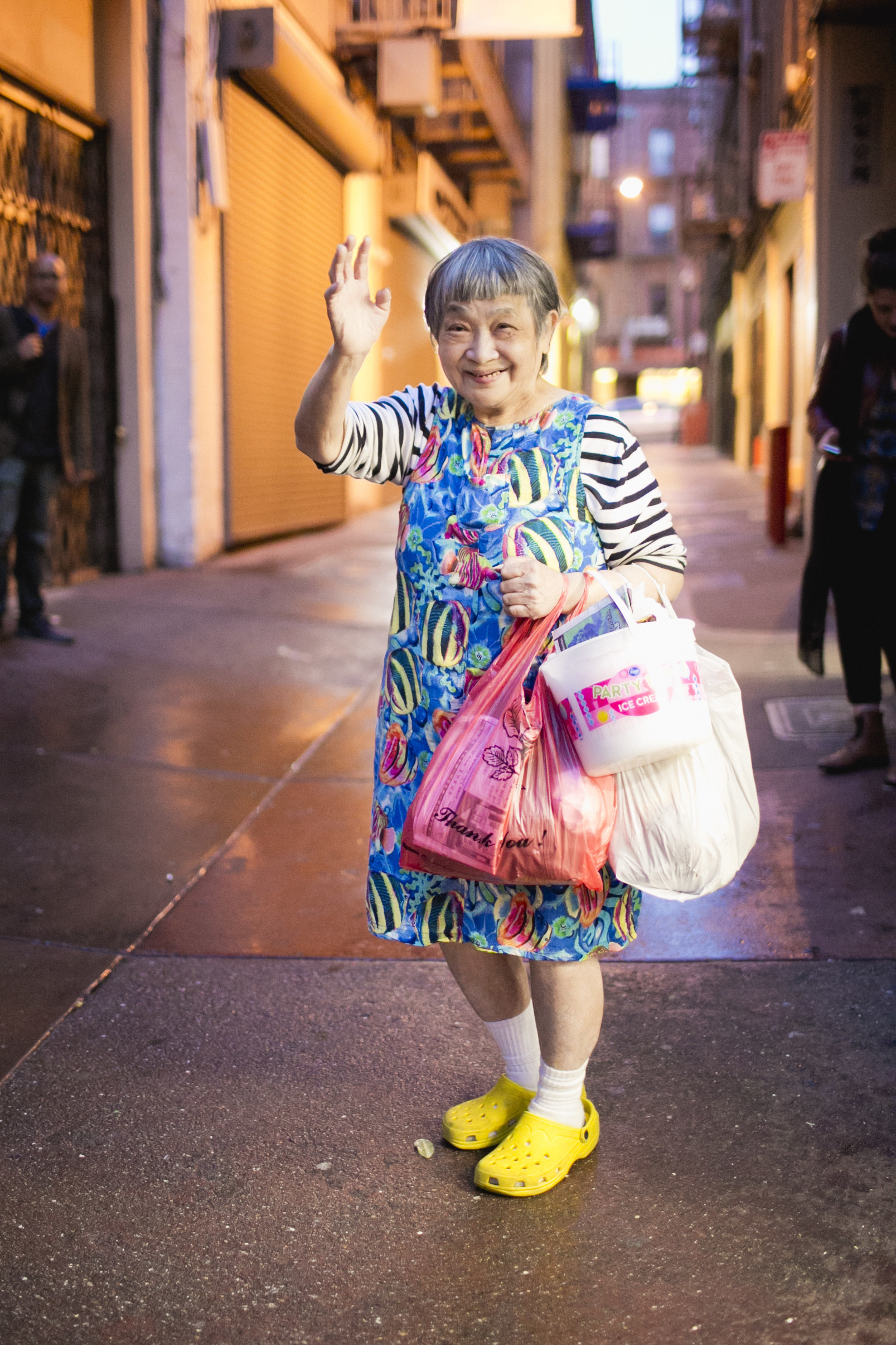
We met Betty Yee at the opening and closing parties for our first Chinatown Pretty photo exhibit at 41 Ross.
She was walking down the alleyway and stopped to peer inside the space, curious about what was going on. We waved her in and became fast friends — she wanted to show us her house and requested that we save our beer cans from the opening party for her to recycle.
At the closing party, she showed up in this great outfit. She had just finished swimming laps at the Chinatown YMCA and appeared in an aquatic look consisting of yellow Crocs and a tropical ocean print dress with a striped shirt underneath.
She grabbed our arms and insisted that we Irish-exit our event. “Come with me to the church — there’s free food!” she said.
“But, Betty, we can’t leave!” we cried.
“Sure you can,” she replied.
We didn’t leave, but we exchanged mailing addresses instead, imagining it wouldn’t be long till we ran into her again.
Dorothy G.C. Quock aka Polka Dot: Cameron House, San Francisco
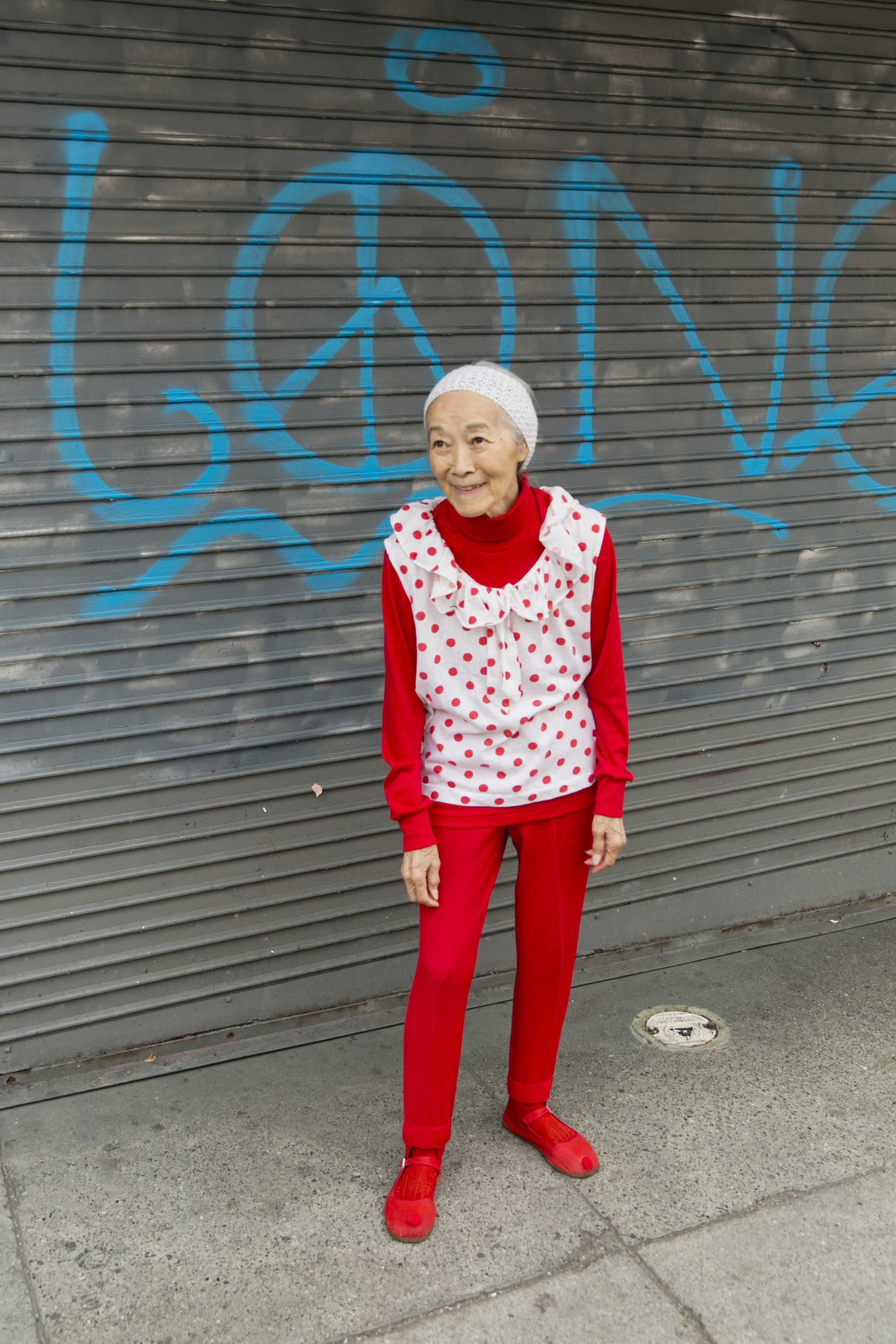
Dorothy G.C. Quock, better known as Polka Dot, got her nickname at Donaldina Cameron House, a Presbyterian family and youth organization in Chinatown. There was another person named Dorothy, so the executive director nicknamed her Polka Dot, and it stuck. At the time, she didn’t wear polka dots much, but now it’s her signature look.
We met her one day at the Cameron House rooftop basketball court, where Polka Dot demonstrated her tai chi moves, which she practices daily. She wore an all-red outfit with a polka dot turtleneck underneath a ruffled shirt. Her accessories included a hair clip with Guatemalan worry dolls (a gift from her daughter) and cotton Mary Janes, to the tips of which she had affixed pom poms to patch up a hole.
“I grew up here,” she said of Cameron House. Polka Dot was in the first group of teens to join the youth program in 1947, when she was 13 years old. On Friday nights they held socials, where teens would learn about “the birds and the bees.” Polka Dot also learned about civic responsibility and politics through the youth program. Although she’s no longer active in the religious aspect of Cameron House, it taught her the importance of social change and community work.
On Mondays, she receives a delivery from the food pantry. She keeps a list of her neighbors and “what they can eat or what they like to eat” on her fridge—and distributes her bounty to them accordingly. Because our city is susceptible to earthquakes and fires, Polka Dot has initiated an emergency response plan for her apartment building, which she created after receiving training through Neighborhood Emergency Response Team (NERT), a San Francisco Fire Department program. Although Polka Dot hasn’t experienced an emergency, there’ve been plenty of false alarms. “There’s old ladies that burn their rice every so often,” Polka Dot said with a laugh.
Shui P. Wong: Seventh Street, Oakland
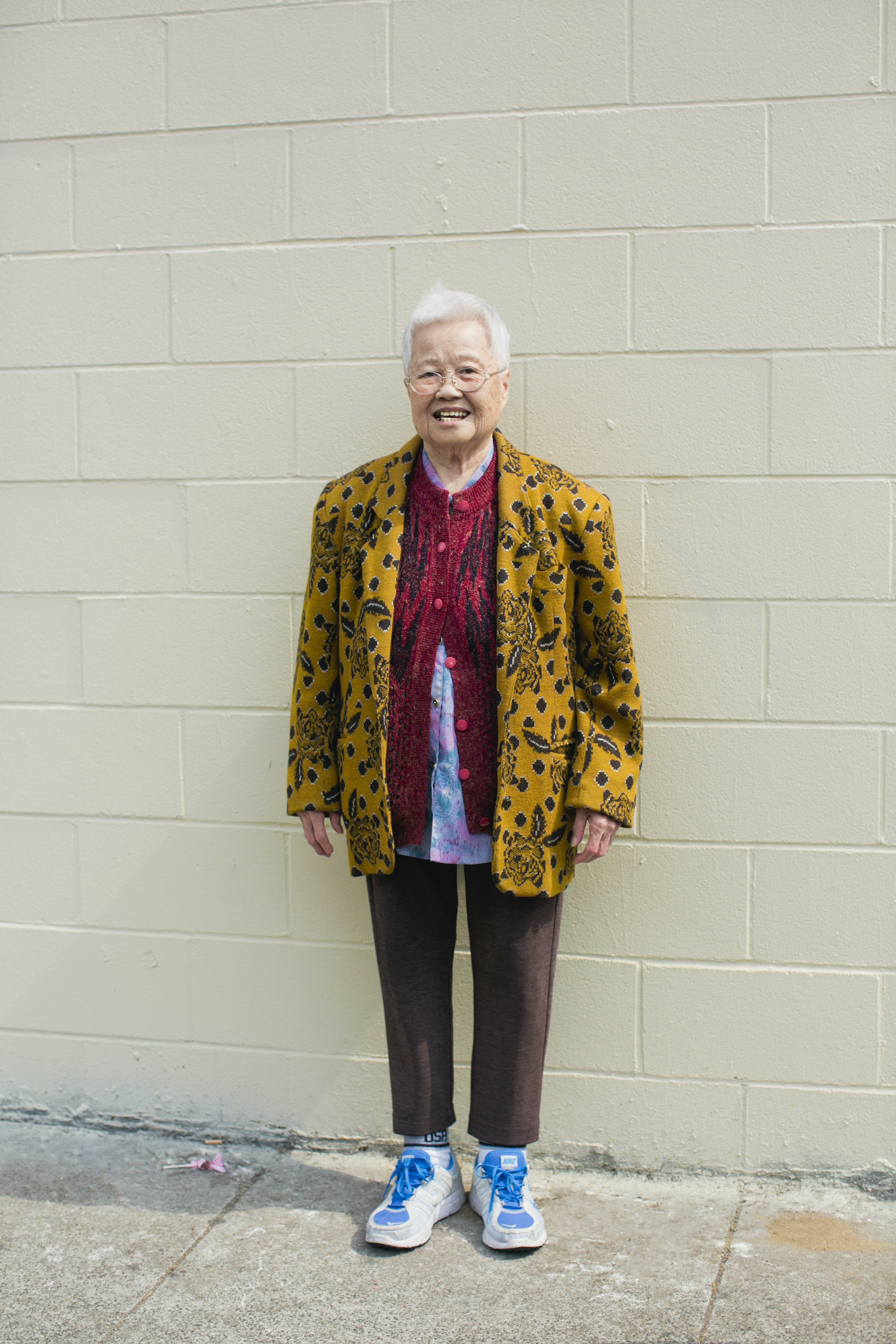
Shui P. Wong, 90, has a knack for color. We met her when she was on her way to dim sum, wearing a mustard yellow blazer on top of a rose patterned cardigan and a watercolor print blouse. The knits looked cozy and coordinated; the pastel shirt offered a fun break. She paired it with thick brown sweatpants that revealed her “USA” socks.
Ms. Wong claims she just wears “whatever,” but her “dozen or so” grandkids beg to differ — they said she’s always been a pro at color coordinating her clothes, many of which they’ve given to her as gifts.
Before immigrating to the States, Ms. Wong worked in a metal factory for 21 years in Guangdong Province. In the United States she worked at a textile factory and as a babysitter. Nowadays, she’s retired and enjoys at least 12 rounds of mahjong every day.
Estelle Kelley: Ross Alley, San Francisco

A regal air preceded Estelle Kelley when she walked into a Senior Portrait Day we hosted at 41 Ross. Her outfit was a mix of Chinatown Pretty with contemporary fashion. She had on a white plaid coat from Kohl’s layered over a patterned zip-up and a color blocked outfit of green and blue that gave it a pleasurable mix of new and old.
“I don’t dress like an old lady,” she said. “I’m 87, but I don’t feel like it.“
Mrs. Kelley was born at the San Francisco Chinese Hospital in 1929. When she was still a baby, her family moved back to China, but as the second Sino-Japanese war devastated China, she was sent back by boat at age 9, along with her sister, to live among her six aunts in San Francisco. One day, at age 11, she was taken to the Ming Quong Home, an orphanage for Chinese girls on Ninth and Fallon, where Lake Merritt BART station stands today. She remembered being driven over and dropped off at the home: “No one told me, ‘This is where you are going to stay.’”
She graduated from high school and got married, but her marriage was annulled once she found out that her husband already had a wife. Shortly after, she realized she was pregnant with her first child. She then got a job as a telephone operator and lived with her ex-husband’s parents. At various points in time, she had to “board out” her daughter and have another family raise her child while she worked.
When she was 21, she met producers from Forbidden City, a Chinese nightclub and cabaret that operated from 1938 to 1970 on Sutter and Grant. It featured Asian singers, musicians, dancers — even acrobats and magicians. They were looking for a dancer and she tried out, even though she didn’t have any experience. “You have rhythm,” they told her, and she got the job.
Mrs. Kelley said that famous people would roll through Forbidden City whenever they were in town: Ronald Reagan, John Wayne, Bob Hope, and other celebrities of that era. “I don’t remember anything from when I was 22 to 27,” she says. “I was a single mom, dancing in the 1950s. Everything was upside down.”
The Jungs: Alpine Recreation Center, Los Angeles
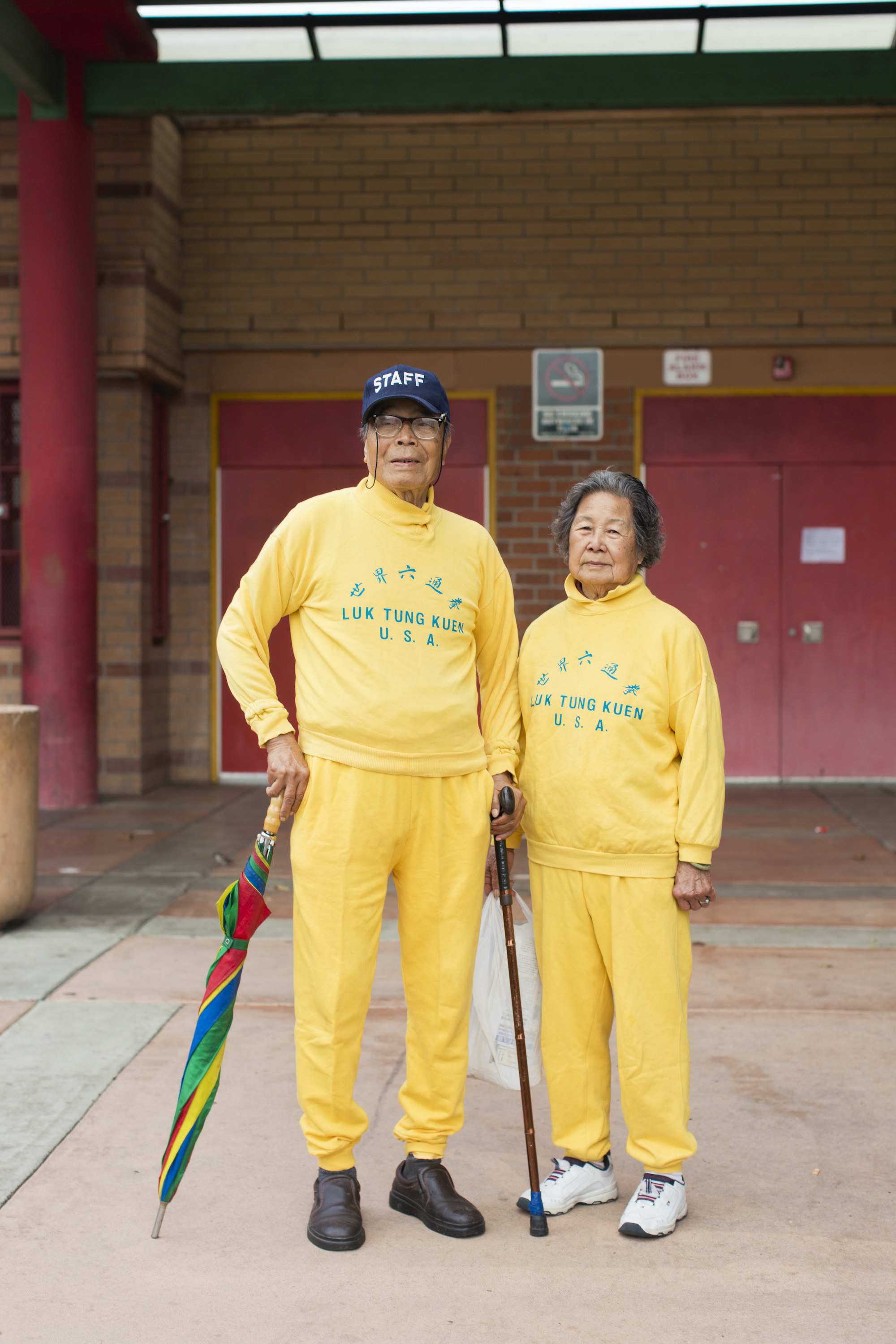
We met the Jungs at the Alpine Recreation Center, where Mrs. Jung, 86, teaches Luk Tung Kuen at eight o’clock every morning. She’s been practicing for 40 years and teaching for the last 20-plus years.
They both wore bright yellow sweatsuits, custom-made in Hong Kong, printed with “Luk Tung Kuen,” an exercise program consisting of 36 movements that promote blood circulation and muscle strength.
The Jungs have owned their sweatsuits for decades, but it looks like they just got them yesterday. The bright blue lettering and a small mock turtleneck collar gave them some flair (as if they didn’t have enough!).
“When it’s a happy day or party, I’ll wear it,” said Mrs. Jung.
Mrs. Jung told me that her husband suffered a stroke a few years ago, so while she teaches, he’ll sit and read or walk around the park — “very slowly,” she added. Mr. Jung said he met his wife through his cousin. We asked how long they dated before they got married. “There was no dating back then,” he said. “You just get married.” He left Hong Kong to come to the United States first, and she joined him two years later in New York.
We asked him about his 69 years of marriage to Mrs. Jung. “How often do you guys celebrate?” we asked. He laughed: “Every ten years.”
Charlie: Chinatown Central Plaza, Los Angeles

We first noticed Charlie’s shoes: patterned high-tops he bought from Goodwill.
Charlie immigrated from Vietnam after the war. “I wanted to find Charlie Chaplin,” he said, an obsession that began after seeing him in a short movie. “His face makes you laugh, so I remembered him.”
Committing Chaplin to memory, he described the actor to his boss in the United States, who then told him Chaplin’s name, which Charlie adopted as his American name. To be more like Charlie, he joined a tap-dancing troupe.
He also found inspiration in another performer, Gene Kelly, which is why he has an umbrella strapped to his backpack so he can also dance in the rain on a moment’s whim. “I imitate him,” he said.
A few other fun facts: Charlie’s a card-carrying member of the Democratic Party. He keeps his membership card around his neck.
We commented on his youthfulness. “What’s the secret?” we asked.
“I know how to live so I live long,” he said. He imparted some wisdom: “Don’t smoke. Don’t drink whiskey. And don’t have too many wives.”
Helen Lo: Mott Street, New York
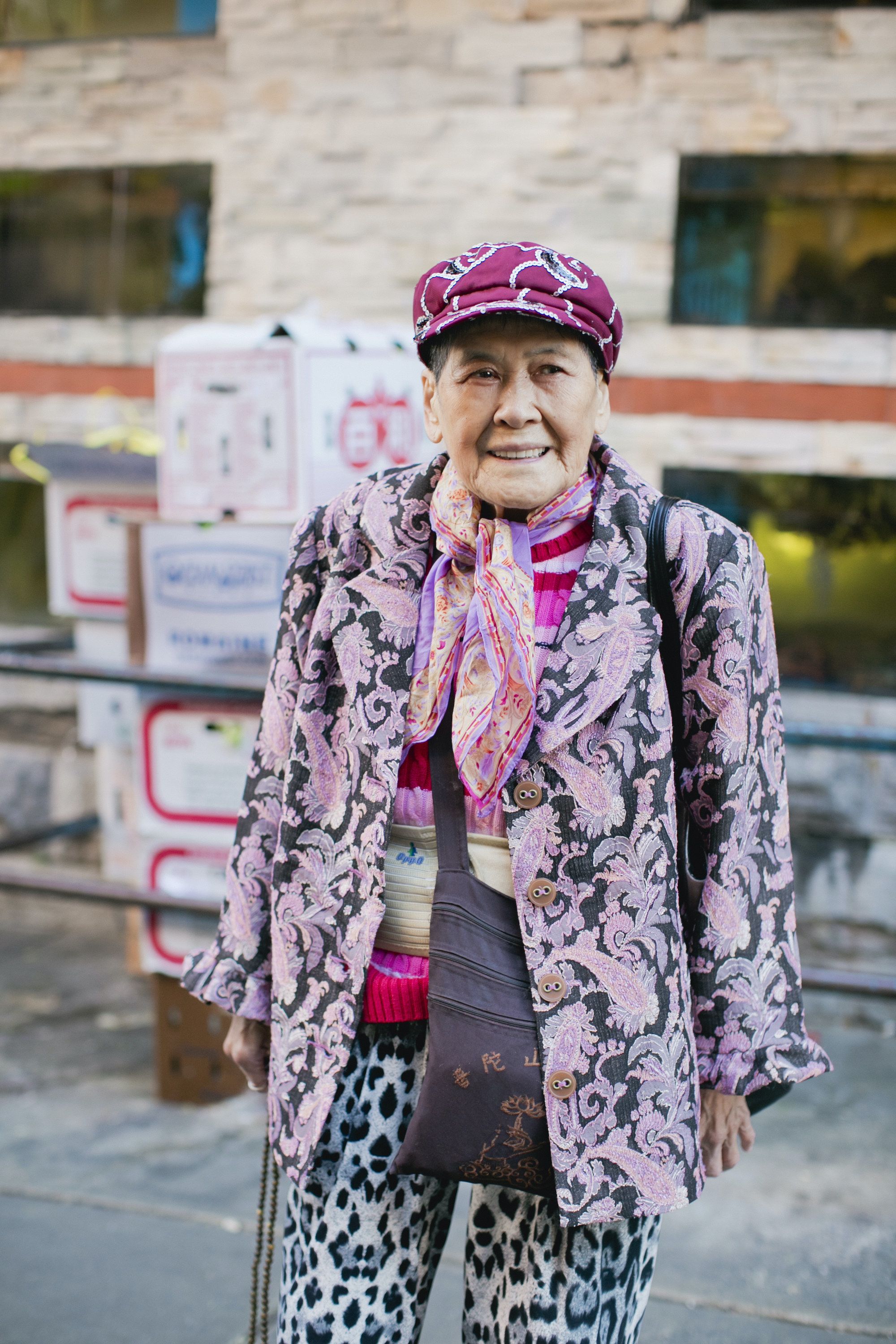
We headed straight for Helen Lo, 80, when we saw her multipatterned outfit halfway down the street. When asked about how she assembled her outfit, she replied: “I like beautiful things and I just put them together.”
Sui Chen Shen: Strathcona Park, Vancouver
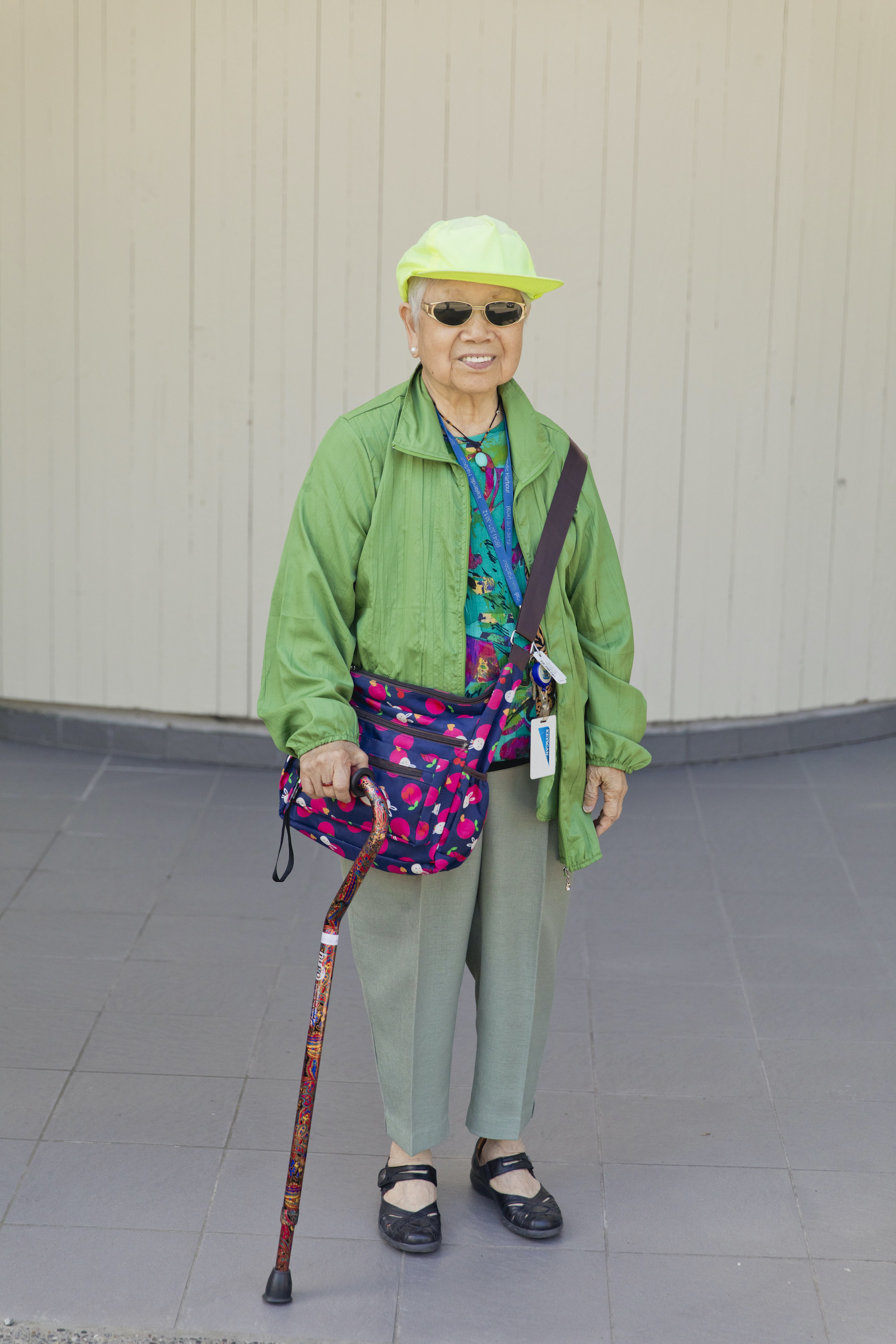
Sui Chen Shen, 86, was glowing in her neon cap after visiting her husband at Villa Cathay, a senior care home.
When she came to Vancouver at 55, Mrs. Shen got a job working at a clothing factory. For seven years, Mrs. Shen steamed clothes to support her four daughters, three of whom lived in the United States. “I was really tired and sweat a lot,” she said. “It was really hot — no air-conditioning.” Eventually, the physically demanding job took its toll. “I had to stand a lot,” she said. “Later my body wasn’t feeling good, so I retired.”
Mrs. Shen’s outfit taught us a lesson on how to balance boldness. We liked the way she mixed patterns, and how the apple green jacket and olive pants harmonized with the brighter elements. She claims there isn’t much to it. “I don’t really have a thought process,” she said. “I wear whatever I feel like.”
Xing Jun Ma: Sun Wah Centre, Vancouver
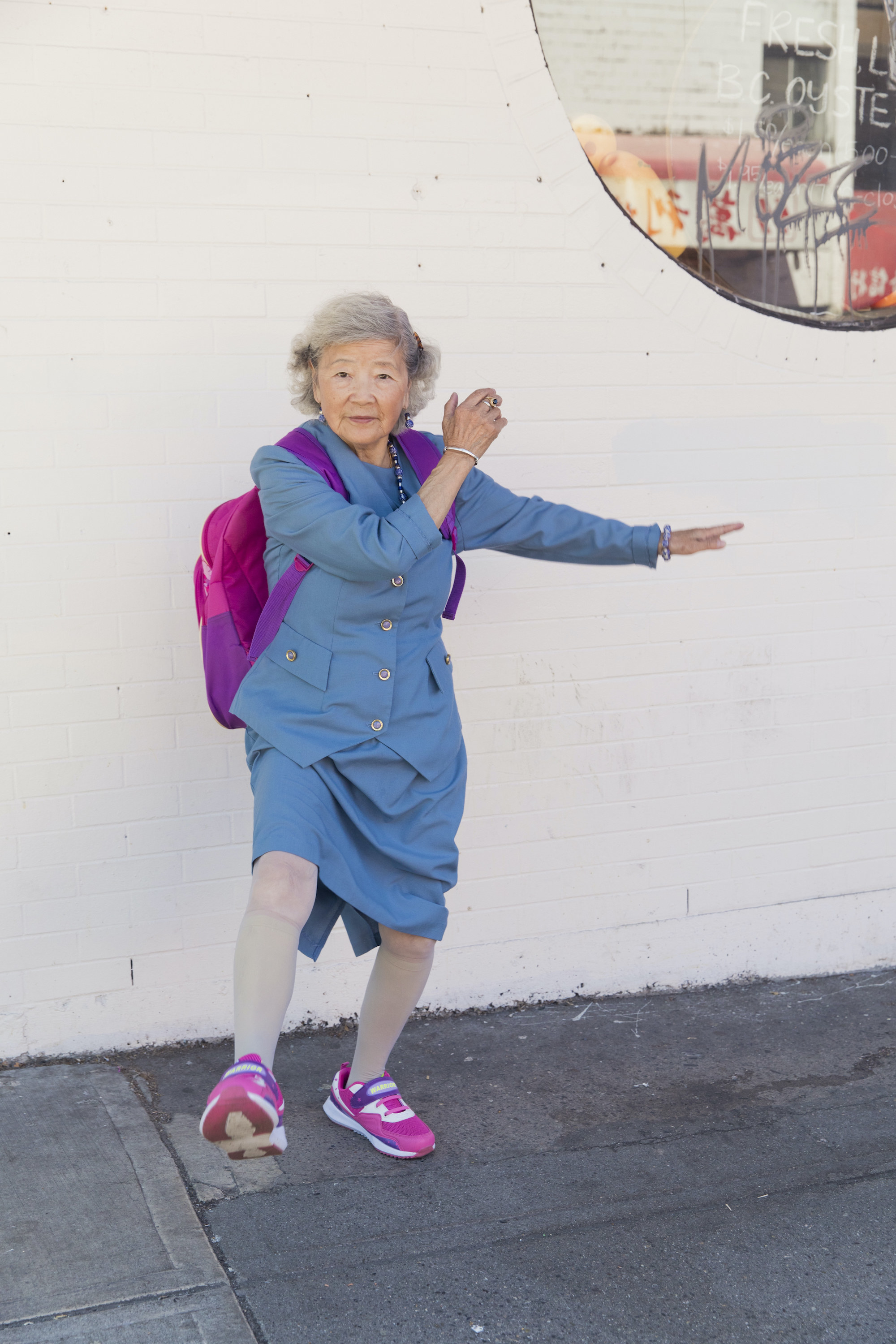
Young and old is the theme of Xing Jun Ma’s look. Ms. Ma, 86, wore a robin’s-egg-blue skirt suit she had custom made in China, after seeing a similar design that she liked. We liked how she accessorized her mature two-piece with a bright pink Dora the Explorer backpack inherited from her great-grandchildren. “They grew out of it so they gave it to me,” she said. “They’re 18 now.”
Her bright pink orthopedic shoes from China (with “Warrior” written in neon) matched her youthful backpack. “My feet aren’t the best,” she said. “These shoes soothe the pain.”
Then, to our surprise, Ms. Ma demonstrated her tai chi skills for us. She’s been practicing Yang-style tai chi for seven years and has competed in Canada, China, and San Francisco. She leads a group of ten tai chi practitioners who meet at MacLean Park every day from 8 a.m. to 9:30 a.m. “I own a radio with the music, so if I don’t go there won’t be any music,” she said.
Man Gei Yuen: Pender Street, Vancouver

We met Man Gei Yuen while she was grocery shopping on Pender Street, the awning casting a red glow on her extra-wide brim visor.
“Everything is from Hong Kong ten years ago,” she said.
Her outfit was feminine and refined — the buckled penny loafers and blazer, with a pearl brooch delightfully placed on her lapel.
It’s the details that provide additional satisfaction. Like how the royal blue in her tropical shirt is picked up by her metal shopping cart. The yellow lenses layered on top of her glasses and the black leather fanny pack give a captivating tweak to the outfit’s tone. Even the bright white stitches exposed by her extra-large pant cuffs add to the feeling. It’s not just practical. It’s edgy.
And lastly, the extra-wide visor, which she had customized. “I can’t really see so I cut up all the ends,” she said.
She made this outfit work for her. And as a result, it works. ●

Excerpted from Chinatown Pretty: Fashion and Wisdom from Chinatown’s Most Stylish Seniors, by Andria Lo and Valerie Luu, published by Chronicle Books 2020
Valerie Luu is a writer and one-half of the Vietnamese pop-up restaurant Rice Paper Scissors. She lives in San Francisco.
Andria Lo is a freelance photographer whose work has been featured in the San Francisco Chronicle, the New York Times, and Wired. She lives in Berkeley.
